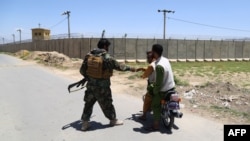Taliban insurgents have continued to make rapid territorial gains in Afghanistan as the United States said its last remaining troops are expected to withdraw from the conflict-torn country by the end of August.
Multiple Afghan sources said Saturday the Taliban had pressured pro-government forces to retreat from at least a dozen districts in northeastern Badakhshan and Takhar border provinces in the past 24 hours. Pro-government forces in many areas are said to be surrendering and abandoning territory without offering any resistance to the Taliban.
More than 300 Afghan border troops escaped the fighting in Badakhshan by fleeing into neighboring Tajikistan, according to the official media of the neighboring Central Asian state.
The Afghan personnel were allowed to enter the Tajik territory “in line with the principles of humanity and good neighborliness,” the report added. Last week, intense clashes with Taliban fighters also prompted scores of Afghan soldiers to flee into Tajikistan.
The latest Taliban advances reportedly have brought the insurgents to the gates of Faizabad, the capital of Badakhshan. A video circulating on Afghan social media Saturday night showed panicked provincial officials boarding a plane along with their families and fleeing the city. VOA could not immediately confirm authenticity of the footage.
The Taliban is on the verge taking Faizabad town of Afghanistan’s Badaghshan province. This afternoon, senior local officials took this flight and escaped to Kabul. Tonight, Faizabad could become the first provincial capital falling to the Taliban. pic.twitter.com/9H9rB5y8gU
— Ezzatullah Mehrdad (@EzzatMehrdad) July 3, 2021
A spokesperson for the Afghan defense ministry, Fawad Aman, said Saturday that national security forces attacked a Taliban-held district near Faizabad and evicted the insurgents. The Taliban suffered heavy casualties, Aman wrote on Twitter.
Fierce fighting was also raging in southern Helmand and Kandahar provinces, where the Taliban claimed their fighters had taken control of several districts.
Over the past 24 hours, more than 300 Taliban fighters were killed in counter-insurgency operations across at least nine provinces, Aman said. But he did not discuss Taliban territorial advances.
#Breaking: Baharak district of Badakhshan was liberated from the control of terrorists again. The Taliban suffered heavy casualties in the operations of the defense and security forces and the people uprising forces and they fled the district.
— Fawad Aman (@FawadAman2) July 3, 2021
Each of the Afghan warring sides routinely issues inflated battlefield gains and casualty tolls for its opponent, and the details are difficult to confirm from independent sources.
Afghan Interior Minister General Abdul Sattar Mirzakwal, referring to the fall of districts to the insurgents, told local TOLOnews Saturday “that war management issues are the main reason behind the ongoing situation.”
Mirzakwal vowed major Afghan city centers “will never collapse” to the Taliban and “provinces are our red line.” He said the insurgents were seeking to take control of key supply routes, but Afghan security forces were determined to “thwart such attempts.”
U.S. officials are actively updating evacuation plans for the U.S. embassy in Kabul, CNN reported Saturday night, given the Taliban offenses and changing U.S. military presence.
Critics say the absence of crucial U.S. air support is behind battlefield setbacks Afghan National Defense and Security Forces (ANDSF) have suffered since the foreign troop pullout began on May 1.
Jonathan Schroden, a military operations analyst at the U.S.-based Center for Naval Analyses, explained the reasons that could be behind the rapid insurgent gains, particularly in northern Afghanistan.
“I suspect the Taliban’s push in the north is a result of both the (relatively) lighter ANDSF presence in those areas and the Taliban’s desire to preempt potential lines of support to (traditionally anti-Taliban) northern warlords and their militias,” Schroden told VOA.
“As for why the ANDSF are retreating, it’s because the government is doing nothing to support them in the field — be it logistics, air support or leadership, Kabul is failing its fielded forces and the latter are voting with their feet,” Schroden said.
On Friday, Washington announced that all U.S. and NATO troops had vacated Bagram Airfield in Afghanistan, where the foreign coalition directed operations against the Taliban and their al-Qaida allies for almost two decades.
The announcement has fueled uncertainty and concerns the country might slide into a new round of civil war, as in the 1990s after the former Soviet Union withdrew its occupation troops.
The United States and its allies invaded Afghanistan in October 2001 just days after deadly terror strikes on America that officials said were plotted by al-Qaida leaders out of their sanctuaries in Afghanistan under the Taliban rule at the time.
The international military action ousted the Taliban from power for sheltering al-Qaida. But the Islamist group quickly organized an insurgency and currently controls or hotly contests more than half of Afghanistan’s more than 400 districts.




